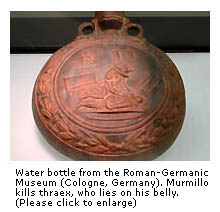Origines
3. Surrender of one of the two gladiators who had fought
so bravely that the audience would ask the editor for his
missio (dismissal) by calling "mitte" or
"missum".
4. 4. The fight ended in a draw, which was very rare. If
the gladiators had shown a long and exciting fight and the
audience was enthusiastic, the editor could ask the
summa rudis (first umpire) to end the duel. These stanti
missi (standing dismissals) were very honorable. They
were valued higher than a victory against a weak opponent.
Some fights were carried out sine missione (without
dismissal) where either case 1 or 2 had to occur. No matter
how bravely the gladiators fought and how exhausted they might
have been already, they had to fight until the bitter end.
Since such fights were very costly - the editor had
to pay a high fee to the lanista for each dead gladiator.
These fights were probably quite rare.
 Given
these costs, only a few fights might actually have ended with
the death of one of the two combatants - in contrast to the
accepted belief that gladiator fights were merely a bloody
spectacle. But the training of a gladiator was very expensive,
thus no lanista would have liked to lose half of his
fighters at an event. Moreover, the fights were no senseless
butchery but obeyed strict rules which were observed by the
summa rudis and the secunda rudis (first and
second umpire). Furthermore, it was regulated what type of
gladiator had to fight which opponent, so that there was always
a balance between the combatants. For example the lightly
armed but agile retiarius fought against the heavily armored
and ponderous secutor. Given
these costs, only a few fights might actually have ended with
the death of one of the two combatants - in contrast to the
accepted belief that gladiator fights were merely a bloody
spectacle. But the training of a gladiator was very expensive,
thus no lanista would have liked to lose half of his
fighters at an event. Moreover, the fights were no senseless
butchery but obeyed strict rules which were observed by the
summa rudis and the secunda rudis (first and
second umpire). Furthermore, it was regulated what type of
gladiator had to fight which opponent, so that there was always
a balance between the combatants. For example the lightly
armed but agile retiarius fought against the heavily armored
and ponderous secutor.
***************
|
